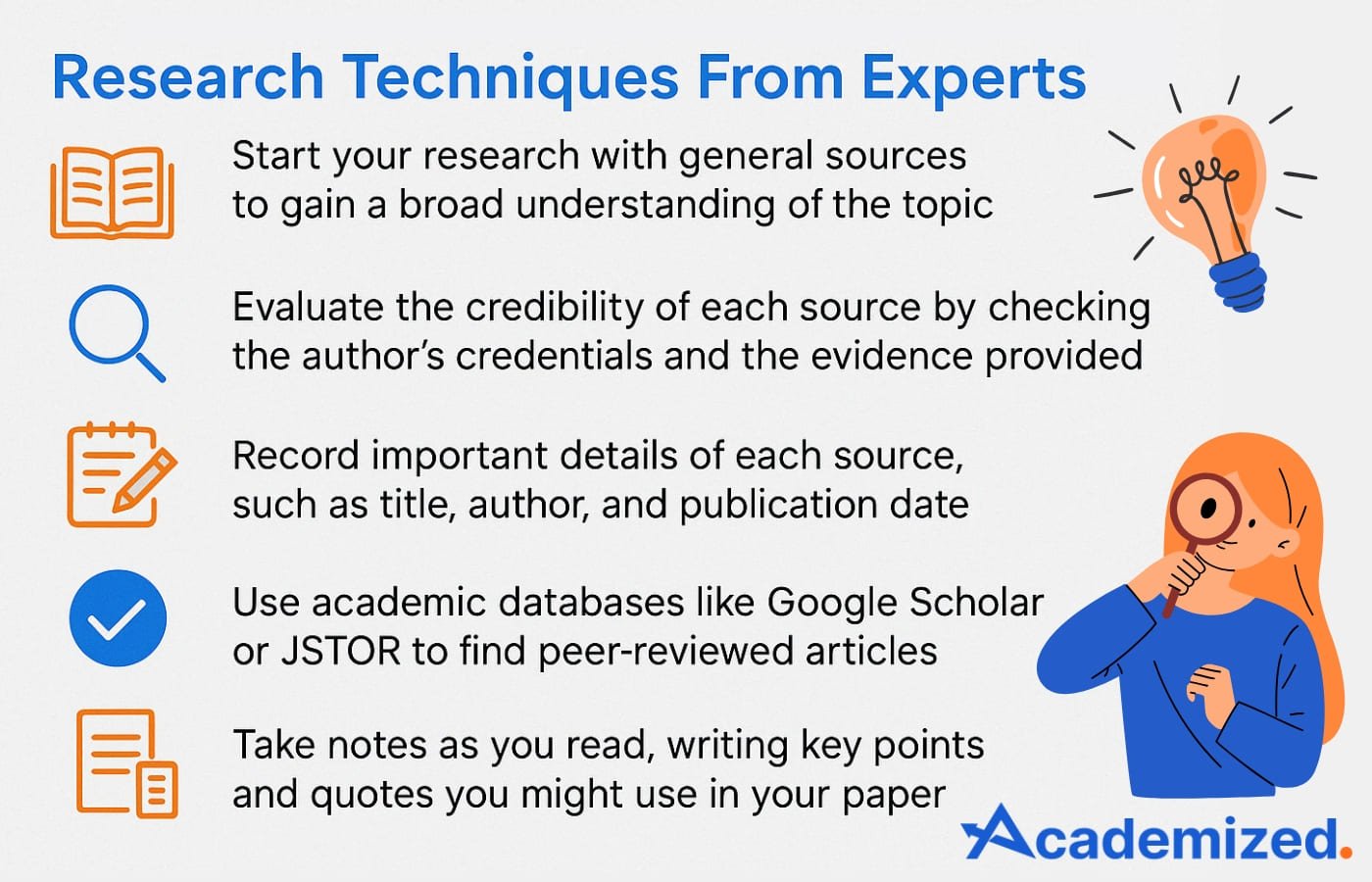- Blog
- How to Write an Extended Essay That Will Truly Impress
How to Write an Extended Essay That Will Truly Impress
 Mary Watson
Mary Watson

Thinking about how to write an extended essay but not sure where to begin? To build a solid extended essay, start by choosing a focused topic, planning your research, and creating a detailed outline. Once the basics are in place, the rest becomes more manageable.
An extended essay gives you a chance to explore a subject you genuinely care about. It’s more than just another school paper – it’s a project where your critical thinking, research, and writing skills get to shine. At around 4,000 words, it takes time and effort, but with the right approach, the results are rewarding.
We’ve worked with many students on essays like these, and one thing is clear: successful extended essays always start with a strong foundation. This means giving enough attention to the planning phase, asking the right research question, and making sure the structure supports your argument. In this article, we’ll guide you through the steps, offer tips that actually work, and help you feel confident about getting started.
What Is an Extended Essay All About
An extended essay is a formal academic project that allows students to explore a subject deeply. Unlike standard essays, it requires independent research and follows a strict format. It’s most commonly written as part of the International Baccalaureate (IB) Diploma Programme, but similar formats appear in other academic contexts.
The biggest difference between this and a regular essay lies in its length and depth. Extended essays usually run about 4,000 words and require a well-defined research question. Students are expected to analyze, argue, and draw conclusions based on sources they evaluate themselves. It's not just about expressing opinions – it’s about building a strong, evidence-based argument.
Read more: Learn How to Make an Essay Longer
Understanding the Requirements for Extended Essays
Before starting, students need a clear view of what’s expected. Knowing how to write an extended paper means understanding the rules, goals, and structure. It’s not the same as writing a regular classroom essay. The requirements help maintain academic rigor and consistency. Here's what every student should keep in mind:
- Word Count: The recommended length is around 4,000 words. That doesn’t include titles, bibliography, or appendices.
- Research Question: Your essay must be centered around a focused and specific question that can be answered through research and analysis.
- Structure: Use a formal structure that includes an introduction, body, conclusion, and references.
- Sources: You need credible, academic-level sources. Proper citation is a must, using a recognized style like MLA, APA, or Chicago.
- Independent Work: While you will likely receive guidance from a supervisor, the research and writing must be your own.
- Reflection: IB extended essays require you to reflect on your research process at several stages.
- Academic Honesty: Plagiarism is taken seriously. All information must be properly cited and quoted.
Choosing the Right Topic for an Extended Essay
Starting with a topic you’re genuinely curious about makes the whole process more enjoyable. A strong topic should be narrow enough to explore in detail but broad enough to allow for research. Trends in current events, literature, science, and global issues often inspire the best topics. Here are ten ideas to spark your thinking:
- How Social Media Shapes Political Awareness Among Teenagers
- The Role of Memory in Character Identity in Contemporary Fiction
- Exploring Mental Health Representations in Young Adult Novels
- Impact of Climate Change Policies on Urban Infrastructure Planning
- The Ethics of AI-Generated Art in Creative Industries
- How Video Games Influence Problem-Solving Skills in Adolescents
- Evaluating Fast Fashion’s Environmental Impact in Emerging Economies
- Censorship and Freedom of Expression in Modern Media Platforms
- How Gender Roles Are Reinforced Through Advertising in the 21st Century
- The Rise of Plant-Based Diets and Their Economic Influence on Agriculture
Tips on Formulating a Research Question
Finding the right research question is one of the most important steps when figuring out how to write a good extended essay. It’s more than just narrowing down a broad topic – it’s about identifying something specific, debatable, and researchable. A strong question gives your essay direction and sets up a clear line of inquiry. Start by exploring your general interest area, then focus on a particular angle you can investigate in depth. Avoid questions that are too descriptive or that can be answered with a simple yes or no.
Research Like a Boss
Once your question is clear, the next step is gathering material that helps you answer it. Aim for reliable academic sources – books, scholarly articles, reports, and primary documents. Keep track of citations early on to save time later. Use research tools like Google Scholar or your school’s library database to find quality sources. Take notes carefully, organizing information by theme or relevance to your essay’s sections. Focus on depth over quantity and always verify the credibility of what you’re using. Solid research forms the backbone of your argument and builds credibility for your analysis. Check out some research techniques below to help you out.

Following a Streamlined Extended Essay Structure
Drafting a strong outline can make the writing process faster and smoother. It helps you see how your ideas connect and where each section should go. Your structure should follow a logical flow that matches the requirements of your extended essay subject. Below is an extended essay outline example you can adapt to your own topic:
1. Title Page
Include the title, subject, word count, and candidate information.
2. Abstract
A short summary (about 300 words) of your research question, method, and findings.
3. Introduction
Present the topic, background, and research question. Explain why the topic is worth investigating.
4. Body Paragraphs
- Section 1: Background context or theoretical framework
- Section 2: Detailed analysis with supporting evidence
- Section 3: Evaluation of arguments or counterpoints
- Section 4: Interpretation of results and findings
5. Conclusion
Summarize key points, restate how the research question was addressed, and mention any limitations or suggestions for future research.
6. References/Bibliography
List all sources using the citation style required by your school or program.
Writing the First Draft with Confidence
Once your outline is clear, the next step is turning your ideas into a complete first draft. Don’t overthink every sentence. Focus instead on getting your thoughts down without obsessing over perfection. A strong draft grows out of structured ideas supported by evidence. Start with your introduction and let your research guide your argument. Developing your main sections around logical progression keeps the paper focused. Keep your argument tied directly to your research question, and remember that writing a thesis for an extended essay means making a clear, defensible claim that shapes your essay from start to finish. Write with clarity, and don’t aim for polish just yet – refinement comes later.
Read more: A Guide on How to Write an Essay Effectively
Revising and Refining Your Work
After completing the first draft, take a short break before reviewing it with fresh eyes. Revision isn’t just about fixing grammar. Focus on clarity, flow, and whether your argument makes sense throughout. Pay attention to the structure and whether your points support your thesis well. Read your work aloud to catch awkward phrasing or weak transitions. Look out for repetition and sections that drift off-topic. Trim what doesn’t serve your core argument, and expand parts that need more context or detail. At this stage, feedback from a peer or supervisor can help spot gaps or confusion you may have missed.
Extended Essay Format Guide and Presentation Tips
Presentation matters just as much as content. Make sure your formatting aligns with IB guidelines or your academic institution’s requirements. Use consistent headings, font, and spacing throughout. Proper citation style (like MLA, APA, or Chicago) should be applied carefully, and bibliographic entries must be complete. Adding page numbers and a clean title page helps give your paper a polished look. These details aren’t just formalities – they show professionalism and attention to detail. Keep our tips for writing an extended essay in mind, and you’ll ensure your essay doesn’t lose marks for minor formatting errors.
Need some extra tips or want us to take a look at your paper? You can always get a custom essay for sale from Academized and expert assistance with editing or proofreading to make your essay shine!
Common Mistakes to Avoid In Your Essay
Many students fall into similar traps while writing extended essays. Here are some pitfalls to steer clear of:
- Picking a topic that’s too broad or vague
- Failing to link evidence clearly to the research question
- Ignoring the importance of a strong thesis
- Overusing quotes instead of analyzing them
- Skipping revision and submitting the first draft
Busy with an insane amount of schoolwork? Just say, "Write academic essays for me," and we will offer timely and affordable academic aid.
3 Extended Essay Example Sections with Commentary and Breakdown
Below, we prepared 3 examples, showcasing the important sections of an extended essay. Take note of the recommendations we share here to make your writing as effective as possible.
Example 1 – Strong Extended Essay Introduction with Context
In recent years, the environmental impact of fast fashion has become a topic of growing concern. This essay explores how consumer behavior contributes to the rise of disposable clothing trends and examines whether sustainable alternatives are economically viable. The research will focus on production practices of high-volume fashion retailers and compare them with emerging sustainable brands to assess the real cost of clothing beyond the price tag.
This introduction does more than introduce a topic – it defines a clear direction. It includes context, outlines the scope of the investigation, and introduces the comparative approach. We selected this excerpt because it models how to frame a focused and purposeful extended essay without vague claims. Students should remember that a strong introduction sets expectations and provides a roadmap for both the writer and the reader.
Example 2 – Well-Developed Extended Essay Body Paragraphs
Offering Strong Analysis
By analyzing Zara’s supply chain, it becomes evident that the brand’s business model prioritizes speed and affordability over sustainability. According to a 2021 industry report, Zara produces over 450 million items annually, much of which is manufactured using energy-intensive processes. Unlike brands that rely on made-to-order systems, Zara keeps minimal stock per item, promoting impulse buying. These practices support high revenue but contribute significantly to textile waste.
We highlighted this paragraph because it combines real data with analysis. The student doesn’t just report information – they connect it directly to the research question and provide a critical viewpoint. This paragraph also models how to embed statistics meaningfully and integrate them into the argument. It encourages students to interpret, not just describe, which is essential in analytical writing.
Featuring Comparing Perspectives
Some education theorists argue that standardized testing creates a measurable framework for assessing academic achievement across diverse populations. However, critics such as Alfie Kohn claim that these exams reduce education to rote memorization and undermine creativity. A 2019 OECD study found that countries with heavy test-based systems often see declining student motivation and engagement over time. This suggests that while testing offers consistency, it may not reflect true learning outcomes or long-term intellectual growth.
We chose this example because it shows how to present contrasting viewpoints within a single paragraph while staying focused on the research aim. The student introduces a balanced perspective, references a relevant study, and then offers an interpretation. It’s a strong example of academic nuance, encouraging students to go beyond a one-sided argument and instead show critical thinking through comparison.
Example 3 – Clear and Focused Extended Essay Conclusion
This investigation finds that while sustainable fashion presents a viable alternative, its impact remains limited without widespread behavioral change. Consumer demand continues to drive fast fashion growth, placing pressure on both policy and industry reform. Although sustainable brands offer promising solutions, meaningful environmental progress will depend on shifting cultural norms and economic incentives to encourage long-term change.
The conclusion summarizes the key findings without repeating points word-for-word. It also reflects on broader implications without losing focus on the essay’s scope. We chose this sample to show students how to end an extended essay with insight rather than simply wrapping things up. A good conclusion leaves the reader with a sense of closure while reinforcing the purpose of the research.
Checklist for a Great Extended Essay
Before submitting your final draft, it’s important to make sure everything aligns with the core expectations for this assignment. Even the strongest ideas fall short if they aren't well-organized, properly formatted, or supported with appropriate sources. To keep things on track, we’ve put together a practical checklist that reflects the most essential extended essay techniques in writing. Use this to double-check your work and make sure no detail gets overlooked:
- A focused, clearly formulated research question is included early in the introduction
- The introduction sets the context and outlines the scope of the research
- Reliable and relevant sources are used and properly cited throughout
- Critical analysis is consistently prioritized over description or summary
- Evidence is always connected to the central argument or research question
- The essay follows a clear structure with smooth transitions between sections
- Arguments and interpretations are logically developed and consistently supported
- The conclusion reflects on the research findings and answers the original question
- All formatting requirements (title page, abstract, contents) are met
- The word count stays within the expected range (no more than 4,000 words)
Subject-Specific Writing Tips for a Strong Extended Essay
Literature
A literature extended essay should offer in-depth analysis rather than a simple summary. Always focus on interpretation, not just description. Choose a text or comparison that allows for a clear argument with strong supporting quotes. Avoid covering too much – narrowing your focus lets you go deeper.
Science
Science-based essays require clear hypotheses and reproducible methods. It’s important to structure your essay like a lab report with introduction, method, results, and discussion. Make sure all data is accurate and explain limitations honestly. Use graphs and charts where appropriate to strengthen your analysis.
Math
Mathematics essays must center around a problem or proof that can be explored logically. Be concise and use definitions and theorems to back up your reasoning. Focus on clarity – explain complex steps in simple terms. Including real-world applications can also add depth to your analysis.
History
History essays demand a balanced use of primary and secondary sources. Stick to a specific time frame or event, and avoid general overviews. Show awareness of different perspectives and interpretations. All claims must be backed with evidence, not opinion, and your conclusion should tie directly to the research question.
Read more: Professional Tips on Writing Different Types of Essays
Final Thoughts and Personal Insights on Writing an Extended Essay
Reflecting on the many students we’ve helped over the years, one truth stands out – writing an extended essay always feels more intimidating than it actually is. What helped me the most as both a student and an academic writer was getting clear about the structure early on. Once the outline felt solid, everything else began to fall into place. I remember guiding one student through a history essay on Cold War propaganda. At first, they felt overwhelmed by the amount of content. But after narrowing the topic and creating a step-by-step plan, their confidence grew – and the final essay earned top marks.
We often remind students that this isn’t a race. The extended essay rewards those who slow down, explore ideas in depth, and revise carefully. The most successful essays we’ve seen come from students who picked topics they genuinely cared about. And yes, struggling with drafts is normal. But if you push through that phase, the result can be something you’re truly proud of. Don’t be afraid to ask for feedback, either. Getting a second pair of eyes truly makes a difference!
FAQ
What’s the best way to begin writing an extended essay?
Start with a focused research question. A strong opening often includes a brief context and a clear line of inquiry. For example:
How did economic factors contribute to the rise of fascism in Italy between 1919 and 1925?
This sets a specific direction from the beginning.
What’s a strong way to end an extended essay?
Close by restating your research question and showing how your findings answered it. Avoid introducing anything new. For instance:
The evidence demonstrates that economic instability played a crucial role in Mussolini’s rise, though it worked in tandem with political and social unrest.
How long is an extended essay supposed to be?
The official word count ranges between 3,500 and 4,000 words. That includes everything from the introduction to the conclusion but excludes the abstract, bibliography, and appendices.
How many hours does it usually take to complete one?
On average, students spend between 30 and 40 hours researching, planning, writing, and revising. Starting early and spreading out the work makes the process much less stressful.
What’s the best strategy for earning an A?
Stay within the guidelines, choose a topic you're genuinely interested in, and plan your time well. Most importantly, focus on analysis rather than summary. Original thought, strong organization, and careful proofreading also go a long way.

Mary, our exceptional editor and online tutor, brings a wealth of knowledge to the table. With her extensive expertise in academic writing, she guides and mentors aspiring students, providing them with constructive feedback that propels their essays to the next level.


 Mary Watson
Mary Watson

